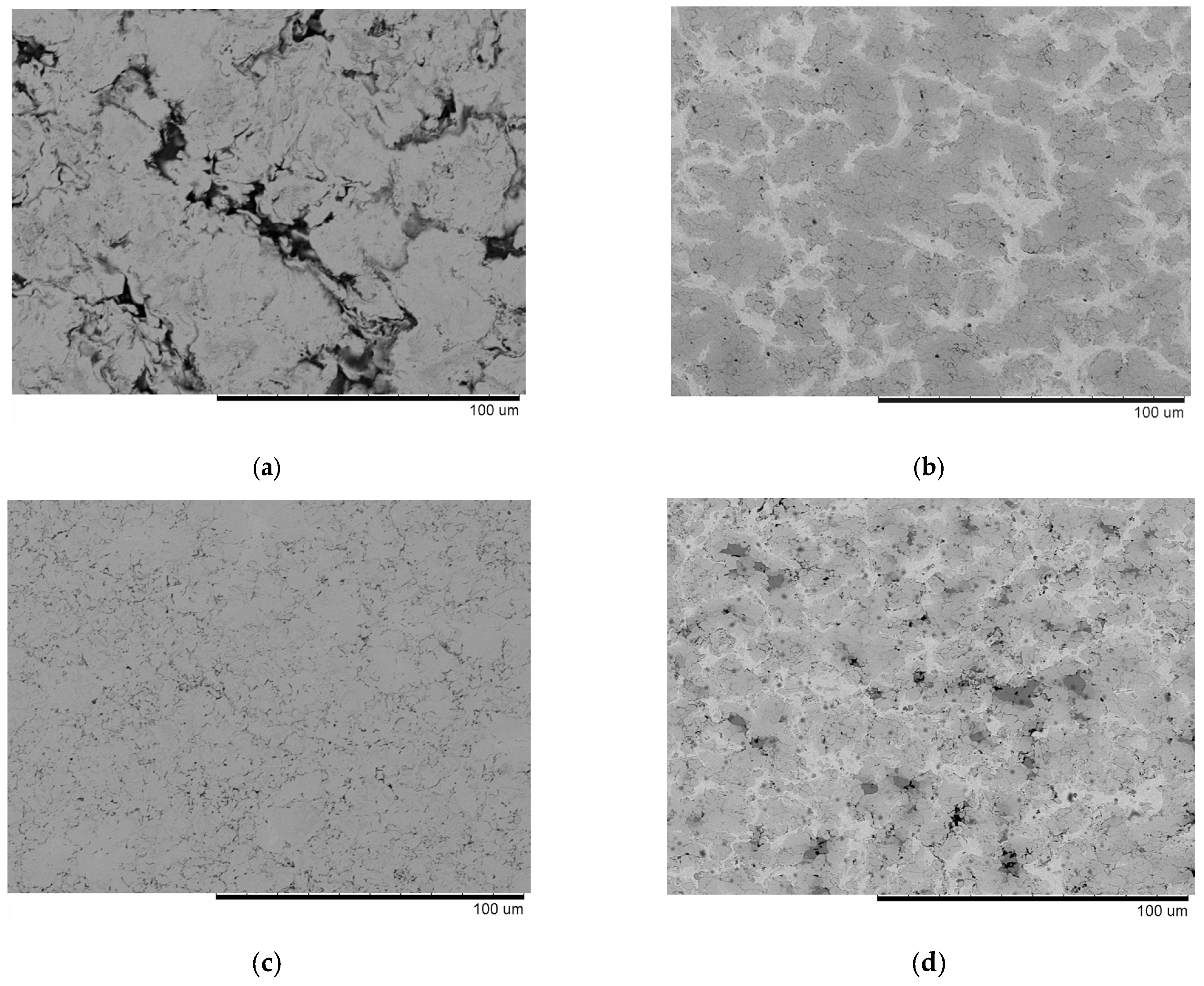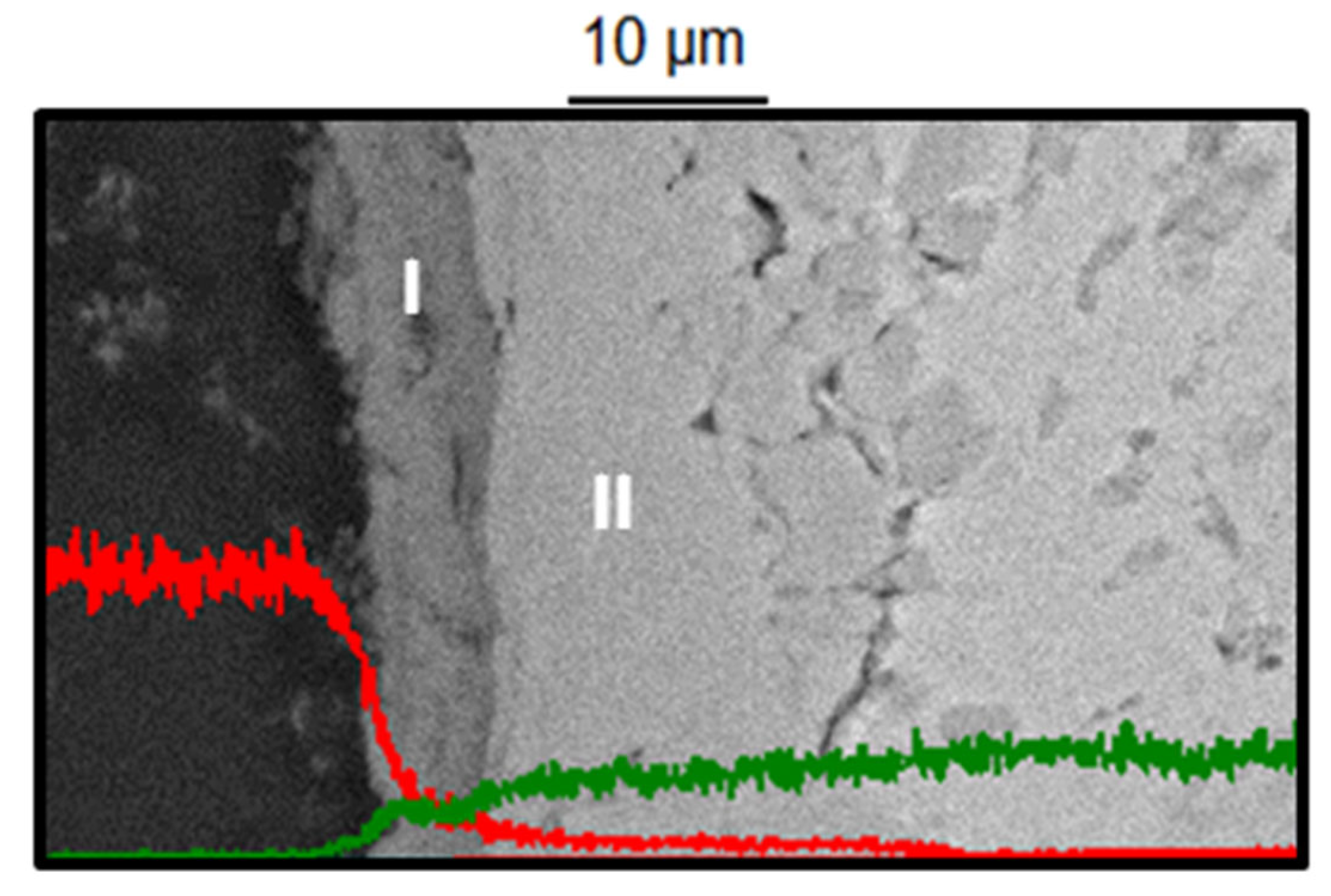Spark Plasma Sintering and Hot Pressing of Cu+Al Powder Mixtures and Pre-Deposited Cu/Al Layers
Abstract
:1. Introduction
2. Materials and Methods
2.1. Starting Powder Materials
2.2. Cold Pressing, Spark Plasma Sintering (SPS) and Hot Pressing (HP) of the Powders
2.3. A Model Experiment: Annealing of the Pre-Sintered Composite
2.4. Formation of Cu/Al Layered Structures by Detonation Spraying and Treatment of the Layers by SPS and HP
2.5. Structural Characterization of the Composite Materials and Hardness Measurements
3. Results and Discussion
3.1. Microstructure and Phase Composition of Composites Obtained by SPS and Pressureless Sintering of Cu-10 wt.% Al
3.2. Kirkendall Effect in the Cu-Al System: A Model Experiment and Analysis of Diffusion Coefficients
3.3. The Influence of the Processing Method (SPS/HP) on the Interaction beween Cu and Al in Sintered Materials and Layered Structures
4. Conclusions
Author Contributions
Funding
Institutional Review Board Statement
Informed Consent Statement
Data Availability Statement
Acknowledgments
Conflicts of Interest
References
- Casati, R.; Vedani, M. Metal matrix composites reinforced by nano-particles—A review. Metals 2014, 4, 65–83. [Google Scholar] [CrossRef]
- Dudina, D.V.; Georgarakis, K. Core–shell particle reinforcements—A new trend in the design and development of metal matrix composites. Materials 2022, 15, 2629. [Google Scholar] [CrossRef] [PubMed]
- Schramm Deschamps, I.; dos Santos Avila, D.; Vanzuita Piazera, E.; Dudley Cruz, R.C.; Aguilar, C.; Klein, A.N. Design of in situ metal matrix composites produced by powder metallurgy—A critical review. Metals 2022, 12, 2073. [Google Scholar] [CrossRef]
- Dudina, D.V.; Georgarakis, K.; Olevsky, E.A. Progress in aluminium and magnesium matrix composites obtained by spark plasma, microwave and induction sintering. Int. Mater. Rev. 2023, 68, 225–246. [Google Scholar] [CrossRef]
- Heinz, A.; Haszler, A.; Keidel, C.; Moldenhauer, S.; Benedictus, R.; Miller, W.S. Recent development in aluminium alloys for aerospace applications. Mater. Sci. Eng. A 2000, 280, 102–107. [Google Scholar] [CrossRef]
- Prados, E.F.; Sordi, V.I.; Ferrante, M. The effect of Al2Cu precipitates on the microstructural evolution, tensile strength, ductility and work-hardening behaviour of a Al–4 wt.% Cu alloy processed by equal-channel angular pressing. Acta Mater. 2013, 61, 115–125. [Google Scholar] [CrossRef]
- Zhai, W.; Lu, W.; Zhang, P.; Zhou, M.; Liu, X.; Zhou, L. Microstructure, mechanical and tribological properties of nickel-aluminium bronze alloys developed via gas atomization and spark plasma sintering. Mater. Sci. Eng. A 2017, 707, 325–336. [Google Scholar] [CrossRef]
- Shaik, M.A.; Golla, B.R. Densification, microstructure and properties of mechanically alloyed and hot-pressed Cu–15 wt% Al alloy. J. Mater. Sci. 2018, 53, 14694–14712. [Google Scholar] [CrossRef]
- Shaik, M.A.; Golla, B.R. Development of highly wear resistant Cu–Al alloys processed via powder metallurgy. Tribol. Int. 2019, 136, 127–139. [Google Scholar] [CrossRef]
- Chesnokov, A.E.; Kosarev, V.F.; Klinkov, S.V.; Smirnov, A.V.; Vidyuk, T.M. Influence of mechanical milling and Heat Treatment on the properties of bronze powder. Inorganic Mater. 2021, 57, 249–254. [Google Scholar] [CrossRef]
- Ondar, A.A.; Dudina, D.V.; Grigoreva, T.F.; Devyatkina, E.T.; Vosmerikov, S.V.; Ukhina, A.V.; Esikov, M.A.; Anisimov, A.G.; Lyakhov, N.Z. Cu–10 wt.% Al alloys produced by spark plasma sintering of powder blends and a mechanically alloyed mixture: A comparative investigation. Powders 2023, 2, 515–524. [Google Scholar] [CrossRef]
- Bedjaoui, W.; Boumerzoug, Z.; Delaunois, F. Solid-state diffusion welding of commercial aluminum alloy with pure copper. Int. J. Autom. Mech. Eng. 2022, 19, 9734–9746. [Google Scholar] [CrossRef]
- Mulyukov, R.R.; Korznikova, G.F.; Nazarov, K.S.; Khisamov, R.K.; Sergeev, S.N.; Shayachmetov, R.U.; Khalikova, G.R.; Korznikova, E.A. Annealing induced phase transformations and hardness evolution in Al–Cu–Al composites obtained by high-pressure torsion. Acta Mech. 2021, 232, 1815–1828. [Google Scholar] [CrossRef]
- Hang, C.J.; Wang, C.Q.; Mayer, M.; Tian, Y.H.; Zhou, Y.; Wang, H.H. Growth behavior of Cu/Al intermetallic compounds and cracks in copper ball bonds during isothermal aging. Microelectron. Reliab. 2008, 48, 416–424. [Google Scholar] [CrossRef]
- Zare, M.; Pouranvari, M. Metallurgical joining of aluminium and copper using resistance spot welding: Microstructure and mechanical properties. Sci. Technol. Weld. Join. 2021, 26, 461–469. [Google Scholar] [CrossRef]
- Shiran, M.K.G.; Khalaj, G.; Pouraliakbar, H.; Jandaghi, M.R.; Dehnavi, A.S.; Bakhtiari, H. Multilayer Cu/Al/Cu explosive welded joints: Characterizing heat treatment effect on the interface microstructure and mechanical properties. J. Manuf. Process. 2018, 35, 657–663. [Google Scholar] [CrossRef]
- Abbasi, M.; Karimi Taheri, A.; Salehi, M.T. Growth rate of intermetallic compounds in Al/Cu bimetal produced by cold roll welding process. J. Alloys Compd. 2001, 319, 233–241. [Google Scholar] [CrossRef]
- Li, L.; Deng, G.; Zhai, W.; Li, S.; Gao, X.; Wang, T. The growth of intermetallic compounds and its effect on bonding properties of Cu/Al clad plates by CFR. Metals 2022, 12, 1995. [Google Scholar] [CrossRef]
- Li, Q.; Zhang, Y.; Cheng, Y.; Zuo, X.; Wang, Y.; Yuan, X.; Huang, H. Effect of temperature on the corrosion behavior and corrosion resistance of copper–aluminum laminated composite plate. Materials 2022, 15, 1621. [Google Scholar] [CrossRef]
- Cheng, Y.; Yuan, X.; Huang, H.; Zuo, X.; Zhang, Y. Salt-spray corrosion behavior of a Cu–Al composite plate under AC current. Mater. Corros. 2020, 71, 608–616. [Google Scholar] [CrossRef]
- Shamsian, M.; Movahedi, M.; Kokabi, A.H.; Ozlati, A. Upset resistance welding of aluminium to copper rods: Effect of interface on performance. Mater. Sci. Technol. 2018, 34, 1830–1838. [Google Scholar] [CrossRef]
- Tokita, M. Progress of spark plasma sintering (SPS) method, systems, ceramics applications and industrialization. Ceramics 2021, 4, 160–198. [Google Scholar] [CrossRef]
- Monchoux, J.P.; Couret, A.; Durand, L.; Voisin, T.; Trzaska, Z.; Thomas, M. Elaboration of metallic materials by SPS: Processing, microstructures, properties, and shaping. Metals 2021, 11, 322. [Google Scholar] [CrossRef]
- Abedi, M.; Sovizi, S.; Azarniya, A.; Giuntini, D.; Seraji, M.E.; Hosseini, H.R.M.; Amutha, C.; Ramakrishna, S.; Mukasyan, A. An analytical review on Spark Plasma Sintering of metals and alloys: From processing window, phase transformation, and property perspective. Crit. Rev. Solid State Mater. Sci. 2023, 48, 169–214. [Google Scholar] [CrossRef]
- German, R.M. Sintering: From Empirical Observations to Scientific Principles; Butterworth-Heinemann: Oxford, UK, 2014; 544p. [Google Scholar]
- Dudina, D.V.; Kvashnin, V.I.; Matvienko, A.A.; Sidelnikov, A.A.; Gavrilov, A.I.; Ukhina, A.V.; Moreira Jorge, A., Jr.; Georgarakis, K. Towards a better understanding of the interaction of Fe66Cr10Nb5B19 metallic glass with aluminum: Growth of intermetallics and formation of Kirkendall porosity during sintering. Chemistry 2023, 5, 138–150. [Google Scholar] [CrossRef]
- Yadav, D.; Bauri, R. Development of Cu particles and Cu core-shell particles reinforced Al composite. Mater. Sci. Technol. 2015, 31, 494–500. [Google Scholar] [CrossRef]
- Savitskii, K.V.; Itin, V.I.; Kozlov, Y.I. The mechanism of sintering of copper-aluminum powder alloys in the presence of a liquid phase. Sov. Powder Metall. Metal Ceram. 1966, 5, 4–9. [Google Scholar] [CrossRef]
- Liu, W.; Cui, J.Z. The Kirkendall effect of the Al-Cu couple with an electric field. J. Mater. Sci. Lett. 1997, 16, 930–932. [Google Scholar] [CrossRef]
- Polyakova, P.V.; Baimova, J.A. The effect of atomic interdiffusion at the Al/Cu interface in an Al/Cu composite on its mechanical Properties: Molecular dynamics. Phys. Metals Metallogr. 2023, 124, 394–401. [Google Scholar] [CrossRef]
- Itin, V.I.; Bratchikov, A.D.; Postnikova, L.N. Use of combustion and thermal explosion for the synthesis of intermetallic compounds and their alloys. Sov. Powder Metall. Metal Ceram. 1980, 19, 315–318. [Google Scholar] [CrossRef]
- Kvashnin, V.I.; Dudina, D.V.; Ukhina, A.V.; Koga, G.Y.; Georgarakis, K. The benefit of the glassy state of reinforcing particles for the densification of aluminum matrix composites. J. Compos. Sci. 2022, 6, 135. [Google Scholar] [CrossRef]
- Ulianitsky, V.Y.; Dudina, D.V.; Shtertser, A.A.; Smurov, I. Computer-controlled detonation spraying: Flexible control of the coating chemistry and microstructure. Metals 2019, 9, 1244. [Google Scholar] [CrossRef]
- Joseph, A.; Gauthier-Brunet, V.; Joulain, A.; Bonneville, J.; Dubois, S.; Monchoux, J.-P.; Pailloux, F. Mechanical properties of Al/ω–Al–Cu–Fe composites synthesized by the SPS technique. Mater. Charact. 2018, 145, 644–652. [Google Scholar] [CrossRef]
- Neumann, G.; Tuijn, C. Self-Diffusion and Impurity Diffusion in Pure Metals: Handbook of Experimental Data; Pergamon: Oxford, UK, 2009; 349p. [Google Scholar]
- Oikawa, H.; Karashima, S. On the self-diffusion coefficients of aluminum in copper (rich)-aluminum solid solutions. Trans. Japan. Inst. Metals 1970, 11, 431–433. [Google Scholar] [CrossRef]
- Rudinsky, S.; Gauvin, R.; Brochu, M. The effects of applied current on one-dimensional interdiffusion between copper and nickel in spark plasma sintering. J. Appl. Phys. 2014, 116, 154901. [Google Scholar] [CrossRef]
- Abedi, M.; Asadi, A.; Sovizi, S.; Moskovskikh, D.; Vorotilo, S.; Mukasyan, A. Influence of pulsed direct current on the growth rate of intermetallic phases in the Ni–Al system during reactive spark plasma sintering. Scr. Mater. 2022, 216, 114759. [Google Scholar] [CrossRef]
- Li, R.; Yuan, T.; Liu, X.; Zhou, K. Enhanced atomic diffusion of Fe–Al diffusion couple during spark plasma sintering. Scr. Mater. 2016, 110, 105–108. [Google Scholar] [CrossRef]
- Garay, J.E.; Anselmi-Tamburini, U.; Munir, Z.A. Enhanced growth of intermetallic phases in the Ni–Ti system by current effects. Acta Mater. 2003, 51, 4487–4495. [Google Scholar] [CrossRef]







| Consolidation Conditions | Estimated Phase Contents, wt.% | Porosity, % | Vickers Hardness, HV1 | ||
|---|---|---|---|---|---|
| Cu | Cu9Al4 | Cu(Al) | |||
| Cold pressing, pressuless sintering, 510 °C | 8 | 22 | 70 | 23 * | 90 ± 5 |
| Cold pressing, SPS, 480 °C, 40 MПa | 30 | 40 | 30 | 1.0 ± 0.3 ** | 250 ± 25 |
| SPS of the mixture, 480 °C, 40 MПa | 30 | 40 | 30 | 1.0 ± 0.3 ** | 205 ± 20 |
Disclaimer/Publisher’s Note: The statements, opinions and data contained in all publications are solely those of the individual author(s) and contributor(s) and not of MDPI and/or the editor(s). MDPI and/or the editor(s) disclaim responsibility for any injury to people or property resulting from any ideas, methods, instructions or products referred to in the content. |
© 2023 by the authors. Licensee MDPI, Basel, Switzerland. This article is an open access article distributed under the terms and conditions of the Creative Commons Attribution (CC BY) license (https://creativecommons.org/licenses/by/4.0/).
Share and Cite
Dudina, D.V.; Bokhonov, B.B.; Gavrilov, A.I.; Ulianitsky, V.Y.; Ukhina, A.V.; Ondar, A.A.; Tikhov, S.F.; Smorygo, O.L. Spark Plasma Sintering and Hot Pressing of Cu+Al Powder Mixtures and Pre-Deposited Cu/Al Layers. J. Compos. Sci. 2023, 7, 466. https://doi.org/10.3390/jcs7110466
Dudina DV, Bokhonov BB, Gavrilov AI, Ulianitsky VY, Ukhina AV, Ondar AA, Tikhov SF, Smorygo OL. Spark Plasma Sintering and Hot Pressing of Cu+Al Powder Mixtures and Pre-Deposited Cu/Al Layers. Journal of Composites Science. 2023; 7(11):466. https://doi.org/10.3390/jcs7110466
Chicago/Turabian StyleDudina, Dina V., Boris B. Bokhonov, Alexander I. Gavrilov, Vladimir Yu. Ulianitsky, Arina V. Ukhina, Aigul A. Ondar, Serguei F. Tikhov, and Oleg L. Smorygo. 2023. "Spark Plasma Sintering and Hot Pressing of Cu+Al Powder Mixtures and Pre-Deposited Cu/Al Layers" Journal of Composites Science 7, no. 11: 466. https://doi.org/10.3390/jcs7110466
APA StyleDudina, D. V., Bokhonov, B. B., Gavrilov, A. I., Ulianitsky, V. Y., Ukhina, A. V., Ondar, A. A., Tikhov, S. F., & Smorygo, O. L. (2023). Spark Plasma Sintering and Hot Pressing of Cu+Al Powder Mixtures and Pre-Deposited Cu/Al Layers. Journal of Composites Science, 7(11), 466. https://doi.org/10.3390/jcs7110466








